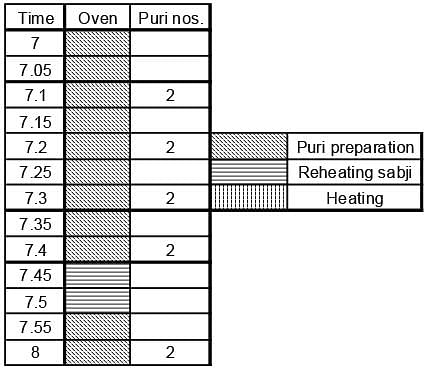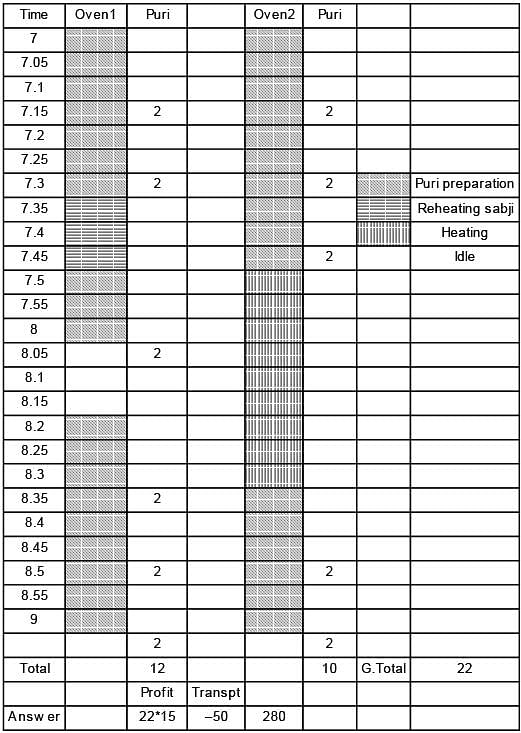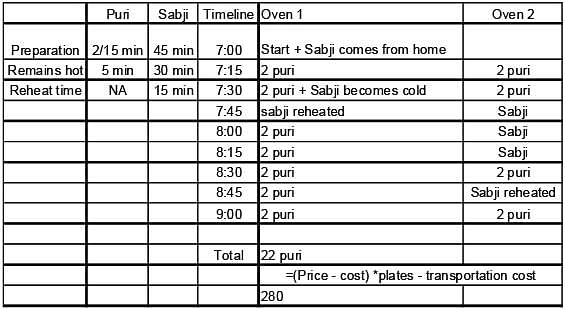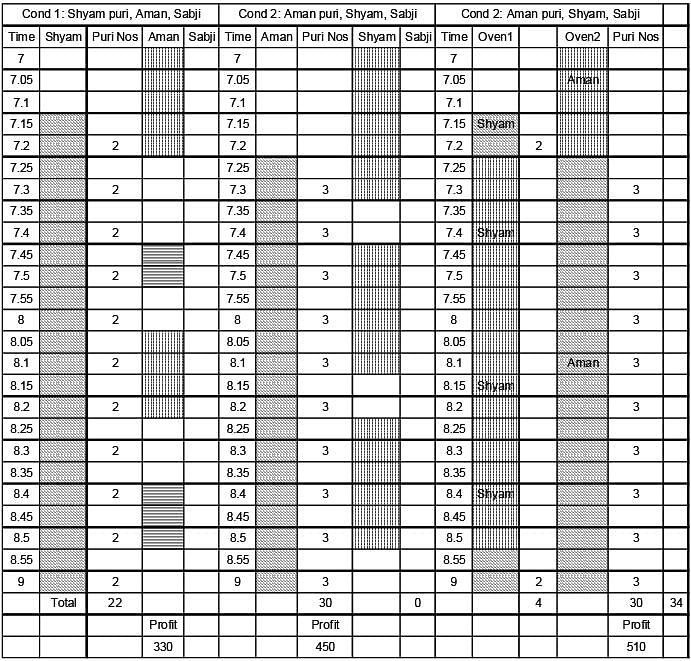XAT 2017: LR DI - CAT MCQ
21 Questions MCQ Test - XAT 2017: LR DI
Analyse the following caselet and answer the questions that follow:
A pastor had eaten at a restaurant with his troupe of ten and his family. It is a norm to tip the waiter and about 20% of a waiter's salary comes from these tips. However, while paying the bill, the pastor crossed out the automatic 18% tip charged for parties of more than eight and wrote "I give God 10% why do you get 18%?" above his signature. The chagrined waitress at the restaurant posted a photo of this on the social media. She was subsequently fired for violating company's policy on customer privacy. This would have been understandable if the restaurant had not posted just 2 weeks ago a customer receipt that was complimenting them. Social media and social activists came heavily upon the management's ambivalent stand and the firing of the waitress. In response, the company posted a note on their social media page defending their actions. This quickly drew over 10,000 comments, mostly negative, to which the management started responding by posting the same note over and over again. There were also accusations of the company deleting negative comments and blocking users. The restaurant also experienced a sizable drop in their footfall.
Q. Who/what is the main cause for the situation becoming unmanageable?
Analyse the following caselet and answer the questions that follow:
A pastor had eaten at a restaurant with his troupe of ten and his family. It is a norm to tip the waiter and about 20% of a waiter’s salary comes from these tips. However, while paying the bill, the pastor crossed out the automatic 18% tip charged for parties of more than eight and wrote “I give God 10% why do you get 18%?” above his signature. The chagrined waitress at the restaurant posted a photo of this on the social media. She was subsequently fired for violating company’s policy on customer privacy. This would have been understandable if the restaurant had not posted just 2 weeks ago a customer receipt that was complimenting them. Social media and social activists came heavily upon the management’s ambivalent stand and the firing of the waitress. In response, the company posted a note on their social media page defending their actions. This quickly drew over 10,000 comments, mostly negative, to which the management started responding by posting the same note over and over again. There were also accusations of the company deleting negative comments and blocking users. The restaurant also experienced a sizable drop in their footfall.
The downward spiral continued for the restaurant as the management persisted in defending their actions and argued with those who criticised them. By the following week, the original post had generated over 18,000 negative comments.
Q. Which of the following is the best way forward for the restaurant at this juncture?
| 1 Crore+ students have signed up on EduRev. Have you? Download the App |
Analyse the following caselet and answer the questions that follow:
Vimla is the domestic help for Shreya and her neighbour Padma; both live in a posh gated community. Vimla not only cleans the house, but also cooks for both the families. Shreya treasures Vimla ever since she joined her family four years ago. Vimla joined Padma's household this year.
One evening Shreya trying to pay the pizza delivery was surprised to find a few five-hundred-rupee notes missing from her purse that she was sure were there earlier. She wants to ascertain if someone has stolen the money. On reflecting, the following facts crossed her mind:
1. In the last one year, Shreya had noticed cash missing on three occasions.
2. Shreya's husband also shared that a few notes were missing from his wallet, though he was not sure if they were stolen.
3. Her eldest son had been pestering Shreya for more pocket money for the last three weeks; in the last few days, he had stopped doing so.
4. In the last one year, Vimla had received six mails from her family asking for money.
5. Her eldest son's expenditure had gone up in the last few days.
Q. Which of the following combinations of the above statements would DECREASE the likelihood that Vimla has stolen the money?
Analyse the following caselet and answer the questions that follow:
Vimla is the domestic help for Shreya and her neighbour Padma; both live in a posh gated community. Vimla not only cleans the house, but also cooks for both the families. Shreya treasures Vimla ever since she joined her family four years ago. Vimla joined Padma's household this year.
Padma discovered some money missing from her purse. She suspects that Vimla has stolen it. She wants to prevent the stealing from happening again and is contemplating the following actions:
1. She should Iet it pass, since to err is human.
2. She should confront Vimla and tell her that she knows the truth and the act is unpardonable regardless of her past service and she is thinking of terminating her services.
3. She should tell Vimla that she is aware someone has stolen money from the house but is not sure who it is.
4. She should share with Vimla that neighbours think Vimla has stolen the money though she doesn't, but is interested in finding out the truth.
5. She should directly ask Vimla if she stole the money, promising her no punishment if she confesses.
Q. Arrange the following combinations of the above actions in the DECREASING order of appropriateness.
Analyse the following caselet and answer the question that follows:
Genius Consulting is a boutique consulting firm started by Shirish, Balram, Rahman and Xavier, four friends from a premier business school. They committed themselves to abide by two principles: a) not to indulge in anything unethical and b) share earnings equally. Genius Consulting could not get a significant project till the following year, when they managed a big one after Rahman's father referred their firm to his top management. Convinced of the team's talent following an impressive presentation, the top management awarded them the project even though six other referred teams made presentations.
The day following the presentation, they met to decide the way forward for the organization.
Q. Which of the following choices would be the most appropriate for Genius Consulting?
Analyse the following caselet and answer the questions that follow:
Mrs Biswas was to retire in one year after serving in the construction department of the Gujarat government for more than thirty years. After retirement, she wanted to spend her retired life along with Mr Biswas, a retired school teacher in a small town in Kerala. They had two children, both studying in Bengaluru. The Biswas' wished to construct a house in Kerala with their life savings. The couple gathered information about owning a house in Kerala. They had four options:
1. Buy a fully furnished house from a big developer and furnish it.
2. Buy a semi-furnished house from a big developer and furnish it.
3. Get a local unregistered contractor to construct a house and furnish it.
4. Mr Biswas with inputs from the family could supervise the construction of a house back in Kerala by employing the best material, engineers, masons and labourers.
Q. Which option would ENSURE the best control of quality of construction for the Biswas'?
Analyse the following caselet and answer the questions that follow:
Mrs Biswas was to retire in one year after serving in the construction department of the Gujarat government for more than thirty years. After retirement, she wanted to spend her retired life along with Mr Biswas, a retired school teacher in a small town in Kerala. They had two children, both studying in Bengaluru. The Biswas' wished to construct a house in Kerala with their life savings. The couple gathered information about owning a house in Kerala. They had four options:
1. Buy a fully furnished house from a big developer and furnish it.
2. Buy a semi-furnished house from a big developer and furnish it.
3. Get a local unregistered contractor to construct a house and furnish it.
4. Mr Biswas with inputs from the family could supervise the construction of a house back in Kerala by employing the best material, engineers, masons and labourers.
Q. Which of the following additional information, IF TRUE, would improve the chances of the third option being preferred?
Analyse the following caselet and answer the questions that follow:
Mrs Biswas was to retire in one year after serving in the construction department of the Gujarat government for more than thirty years. After retirement, she wanted to spend her retired life along with Mr Biswas, a retired school teacher in a small town in Kerala. They had two children, both studying in Bengaluru. The Biswas' wished to construct a house in Kerala with their life savings. The couple gathered information about owning a house in Kerala. They had four options:
1. Buy a fully furnished house from a big developer and furnish it.
2. Buy a semi-furnished house from a big developer and furnish it.
3. Get a local unregistered contractor to construct a house and furnish it.
4. Mr Biswas with inputs from the family could supervise the construction of a house back in Kerala by employing the best material, engineers, masons and labourers.
The Kerala Government recently announced a policy: In case of major quality infringement, the builder will pay a penalty of 50% of the price of the house in addition to the price of the house, to the client within a year of notice.
Q. Rank in ASCENDING order the options that would ensure "control of quality".
Analyse the following caselet and answer the questions 33-35 that follow:
A University coach was asked to select teams in three sports: Shooting, Cricket (batsmen only) and "Snakes & Ladder". The honest and keen observer head boy of the school informed the coach that he had observed 100 students playing the three games - shooting, cricket and "Snakes & Ladder". In shooting, all students were given 100 chances to hit a target. In cricket, a batsman faced a maximum of 100 balls, provided he DID NOT GET OUT. In "Snakes & Ladder", every student could play 100 matches, one each with the other students and one against a computer. In shooting, a player got one point for hitting the target and zero point for missing the target. In cricket, a batsman got one point for hitting the ball and zero point for missing it. In "Snakes & Ladder", a person got one point for winning the game and zero for losing. To the coach's utter surprise, the distribution of points across all three games was the same. It was as follows:
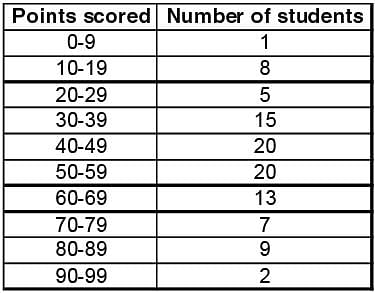
The coach has to select a team of eleven in each sport.
Q. Which of the following options is the best way to select the "Snakes & Ladder" team?
Analyse the following caselet and answer the questions 33-35 that follow:
A University coach was asked to select teams in three sports: Shooting, Cricket (batsmen only) and "Snakes & Ladder". The honest and keen observer head boy of the school informed the coach that he had observed 100 students playing the three games - shooting, cricket and "Snakes & Ladder". In shooting, all students were given 100 chances to hit a target. In cricket, a batsman faced a maximum of 100 balls, provided he DID NOT GET OUT. In "Snakes & Ladder", every student could play 100 matches, one each with the other students and one against a computer. In shooting, a player got one point for hitting the target and zero point for missing the target. In cricket, a batsman got one point for hitting the ball and zero point for missing it. In "Snakes & Ladder", a person got one point for winning the game and zero for losing. To the coach's utter surprise, the distribution of points across all three games was the same. It was as follows:
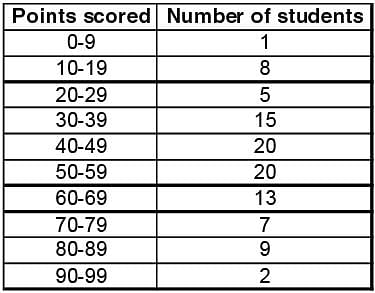
The coach has to select a team of eleven in each sport.
Q. Which of the following options is the best way of selecting the Shooting team?
Analyse the following caselet and answer the questions 33-35 that follow:
A University coach was asked to select teams in three sports: Shooting, Cricket (batsmen only) and "Snakes & Ladder". The honest and keen observer head boy of the school informed the coach that he had observed 100 students playing the three games - shooting, cricket and "Snakes & Ladder". In shooting, all students were given 100 chances to hit a target. In cricket, a batsman faced a maximum of 100 balls, provided he DID NOT GET OUT. In "Snakes & Ladder", every student could play 100 matches, one each with the other students and one against a computer. In shooting, a player got one point for hitting the target and zero point for missing the target. In cricket, a batsman got one point for hitting the ball and zero point for missing it. In "Snakes & Ladder", a person got one point for winning the game and zero for losing. To the coach's utter surprise, the distribution of points across all three games was the same. It was as follows:
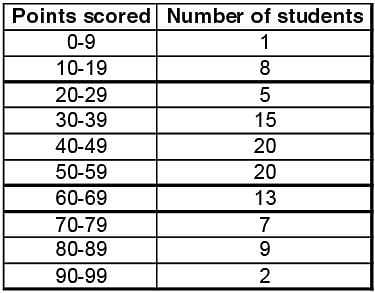
The coach has to select a team of eleven in each sport.
Q. Which of the following options is the correct statement for picking up the cricket team?
Analyse the following caselet and answer the questions that follow:
A college campus with a population of around 2,000 of whom 200 were children, 1,200 people between 15 and 45 years, 500 people between 45 and 65 and around 100 people more than 65 years of age. The campus has two big gates opening out to the city. There are 400 cars and 500 motorbikes inside the campus. The residents relied on these vehicles to visit the city located 10 kilometres away.
Now, with land within the campus becoming scarce, the chief administrator (CA) found the growing demand for parking lot difficult to handle. The faculty, staff and students wanted increased parking space. In the past six years, the parking requirement on campus had doubled. The CA found it inappropriate to construct parking lots from the students' fee, even though those with vehicles may not complain about it.
Besides creating parking problems, the CA felt that these vehicles added to the pollution and made residents less responsible towards each other. The risk to the children and the elderly because of over-speeding was menacing. Therefore, the CA wanted to reduce the number of vehicles in the campus. Many faculty members, students and staff members, however, felt that demand for more parking space was natural as vehicles were required to go to the market, railway station, airport, and inter-state bus terminal all located in the city. They also told the CA that the elderly, sick and the toddlers relied only on these vehicles.
After listening to all stakeholders, the CA wanted to solve these problems while ensuring the campus remained responsible and green.
Q. Which of the following actions would best satisfy all the stakeholders within the campus?
Analyse the following caselet and answer the questions that follow:
A college campus with a population of around 2,000 of whom 200 were children, 1,200 people between 15 and 45 years, 500 people between 45 and 65 and around 100 people more than 65 years of age. The campus has two big gates opening out to the city. There are 400 cars and 500 motorbikes inside the campus. The residents relied on these vehicles to visit the city located 10 kilometres away.
Now, with land within the campus becoming scarce, the chief administrator (CA) found the growing demand for parking lot difficult to handle. The faculty, staff and students wanted increased parking space. In the past six years, the parking requirement on campus had doubled. The CA found it inappropriate to construct parking lots from the students' fee, even though those with vehicles may not complain about it.
Besides creating parking problems, the CA felt that these vehicles added to the pollution and made residents less responsible towards each other. The risk to the children and the elderly because of over-speeding was menacing. Therefore, the CA wanted to reduce the number of vehicles in the campus. Many faculty members, students and staff members, however, felt that demand for more parking space was natural as vehicles were required to go to the market, railway station, airport, and inter-state bus terminal all located in the city. They also told the CA that the elderly, sick and the toddlers relied only on these vehicles.
After listening to all stakeholders, the CA wanted to solve these problems while ensuring the campus remained responsible and green.
Q. Which of the following would be the best option to increase revenue, decrease carbon footprint and still satisfy all the stakeholders in the campus?
Analyse the following caselet and answer the questions that follow:
Girirajan an unemployed youngster from Kumbakonam, Tamilnadu, visited Singapore where his school friend worked as software engineer. In Singapore, Girirajan realized that there were a lot of Tamils in "Little India" area. He soon assessed that there were very few restaurants serving authentic Tamil food and decided to set-up a restaurant "Giri's" in "Little India” serving authentic Tamil food in traditional banana leaf. Customers loved the food. Very soon word spread about the good quality food served in the traditional way. Girirajan expanded operation recruiting 10 employees, all Tamils.
Six months later, Girirajan realized that a lot of Kannadiga and Telugu customers started visiting the restaurant along with their Tamil friends. One day, a Kannadiga customer looking for Devangere Benne Dosa suggested that it may not be a bad idea for Girirajan to serve Karnataka and Andhra cuisines along with Tamil.
With time, the popularity of the restaurant kept soaring. As a result, a lot of Malays, Indonesians and Chinese started visiting the restaurant. His software engineer friend advised to cater to customers of all nationalities, Despite his desire to go grand, Girirajan realized he did not have enough money to get extra space anywhere in Singapore and banks were also reluctant to lend.
One day, while assessing the business, he realized that the restaurant had 90% occupancy rate during peak hours and 40% during the non-peak hours. Both figures were increasing with time.
Q. Which of the following options would be most suitable for the growth of the business?
Analyse the following caselet and answer the questions that follow:
Girirajan an unemployed youngster from Kumbakonam, Tamilnadu, visited Singapore where his school friend worked as software engineer. In Singapore, Girirajan realized that there were a lot of Tamils in "Little India" area. He soon assessed that there were very few restaurants serving authentic Tamil food and decided to set-up a restaurant "Giri's" in "Little India” serving authentic Tamil food in traditional banana leaf. Customers loved the food. Very soon word spread about the good quality food served in the traditional way. Girirajan expanded operation recruiting 10 employees, all Tamils.
Six months later, Girirajan realized that a lot of Kannadiga and Telugu customers started visiting the restaurant along with their Tamil friends. One day, a Kannadiga customer looking for Devangere Benne Dosa suggested that it may not be a bad idea for Girirajan to serve Karnataka and Andhra cuisines along with Tamil.
With time, the popularity of the restaurant kept soaring. As a result, a lot of Malays, Indonesians and Chinese started visiting the restaurant. His software engineer friend advised to cater to customers of all nationalities, Despite his desire to go grand, Girirajan realized he did not have enough money to get extra space anywhere in Singapore and banks were also reluctant to lend.
One day, while assessing the business, he realized that the restaurant had 90% occupancy rate during peak hours and 40% during the non-peak hours. Both figures were increasing with time.
Girirajan started analysing his quarterly customer data to assess growth opportunities. He discovered that 20 % of his customers are Kannadigas and many of them were requesting for a few Karnataka dishes. He was not sure if it was a good idea to serve Karnataka food. He wanted to experiment before taking the final call.
Q. Which of the following options will be worth experimenting in the next fortnight?
Analyse the following caselet and answer the questions that follow:
Girirajan an unemployed youngster from Kumbakonam, Tamilnadu, visited Singapore where his school friend worked as software engineer. In Singapore, Girirajan realized that there were a lot of Tamils in "Little India" area. He soon assessed that there were very few restaurants serving authentic Tamil food and decided to set-up a restaurant "Giri's" in "Little India” serving authentic Tamil food in traditional banana leaf. Customers loved the food. Very soon word spread about the good quality food served in the traditional way. Girirajan expanded operation recruiting 10 employees, all Tamils.
Six months later, Girirajan realized that a lot of Kannadiga and Telugu customers started visiting the restaurant along with their Tamil friends. One day, a Kannadiga customer looking for Devangere Benne Dosa suggested that it may not be a bad idea for Girirajan to serve Karnataka and Andhra cuisines along with Tamil.
With time, the popularity of the restaurant kept soaring. As a result, a lot of Malays, Indonesians and Chinese started visiting the restaurant. His software engineer friend advised to cater to customers of all nationalities, Despite his desire to go grand, Girirajan realized he did not have enough money to get extra space anywhere in Singapore and banks were also reluctant to lend.
One day, while assessing the business, he realized that the restaurant had 90% occupancy rate during peak hours and 40% during the non-peak hours. Both figures were increasing with time.
Girirajan experimented with Karnataka food for a fortnight. He collected sales data for Karnataka food along with the trend of overall sales for the last seven days.
Q. Which of the following datasets, IF TRUE, will give Girirajan greater confidence to continue serving Karnataka food? (Figures below represent Karnataka food sales as percentage of total sales.)
Analyse the following caselet and answer the questions that follow:
Shyam prepares and sells piping hot puri and sabji (gravy) from 7:00 am to 9:00 am (both inclusive) through a stall at XLRI campus. Presently, he has just a single oven, which can do only one job at a time. It takes 30 minutes to cook one handi (a large bowl) of sabji, sufficient for 12 customers. It takes him 10 minutes to prepare 2 plates of puri at a time. While the cost of a plate of puri-sabji is ₹10, the price is ₹25. Puri stays hot for only 5 minutes after preparation, while sabji stays hot for 30 minutes only. It takes 10 minutes to reheat the sabji which stays hot for another 30 minutes. If he brings a handi of hot sabji from home, the transport would cost him ₹50. It can also stay hot for 30 minutes excluding the transportation time. Currently, every 20 minutes five plates are ordered. All unsold quantities are distributed at cost after 9:30 am.
Q. Find the maximum number of plates of puri-sabjiShyam can sell in the first hour of business?
Analyse the following caselet and answer the questions that follow:
Shyam prepares and sells piping hot puri and sabji (gravy) from 7:00 am to 9:00 am (both inclusive) through a stall at XLRI campus. Presently, he has just a single oven, which can do only one job at a time. It takes 30 minutes to cook one handi (a large bowl) of sabji, sufficient for 12 customers. It takes him 10 minutes to prepare 2 plates of puri at a time. While the cost of a plate of puri-sabji is ₹10, the price is ₹25. Puri stays hot for only 5 minutes after preparation, while sabji stays hot for 30 minutes only. It takes 10 minutes to reheat the sabji which stays hot for another 30 minutes. If he brings a handi of hot sabji from home, the transport would cost him ₹50. It can also stay hot for 30 minutes excluding the transportation time. Currently, every 20 minutes five plates are ordered. All unsold quantities are distributed at cost after 9:30 am.
Shyam's puri-sabji became famous. Now he gets 5 orders per 10 minutes and has invested in an additional oven. As he is working alone on both the ovens simultaneously, now in any one oven it takes him 45 minutes to cook one handi of sabji, 15 minutes for 2 plates of puri and 15 minutes to reheat the sabji. He can bring only one handi from home.
Q. What will be his maximum daily profit?
Analyse the following caselet and answer the questions that follow:
Shyam prepares and sells piping hot puri and sabji (gravy) from 7:00 am to 9:00 am (both inclusive) through a stall at XLRI campus. Presently, he has just a single oven, which can do only one job at a time. It takes 30 minutes to cook one handi (a large bowl) of sabji, sufficient for 12 customers. It takes him 10 minutes to prepare 2 plates of puri at a time. While the cost of a plate of puri-sabji is ₹10, the price is ₹25. Puri stays hot for only 5 minutes after preparation, while sabji stays hot for 30 minutes only. It takes 10 minutes to reheat the sabji which stays hot for another 30 minutes. If he brings a handi of hot sabji from home, the transport would cost him ₹50. It can also stay hot for 30 minutes excluding the transportation time. Currently, every 20 minutes five plates are ordered. All unsold quantities are distributed at cost after 9:30 am.
Shyam’s stall was becoming popular by the day. Now he gets 5 customers every 10 minutes. After buying a second oven, he employed a helping hand, Aman at 100 for two hours. Aman can cook one handi of sabji in 20 minutes or can prepare 3 plates of purl in 10 minutes. Reheat time for sabji is 10 minutes. None of them can work on both the ovens simultaneously.
Q. Which of the following options will help Shyam maximize his daily profit, if he does NOT bring sabji from home?
Analyse the following caselet and answer the question that follows:
As a newly started organization in the IT sector, Saksha IT is a fast growing 400 employee organization. Its head, Saksha Kumar believes in building an organization driven by humility.
Q. Which of the following policies would best help him achieve that?
Analyse the following caselet and answer the question that follows:
Principal Maheswari of BINK School of Management is facing a problem that calls for quick action. She received an anonymous mail one day, possibly from one of the students, complaining about outdated syllabi, mediocre teachers and poor choice of courses on offer.
Q. Which of the following is the best course of action available to the Principal?


